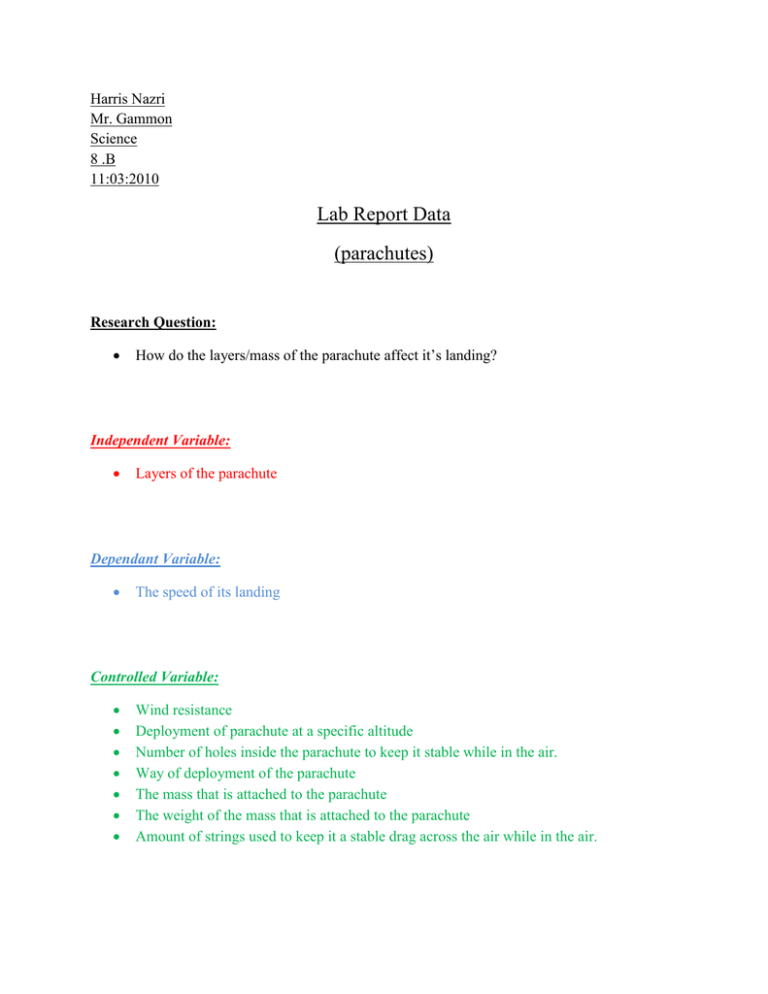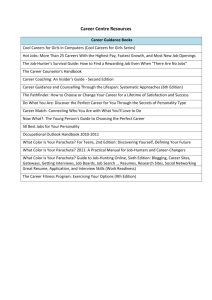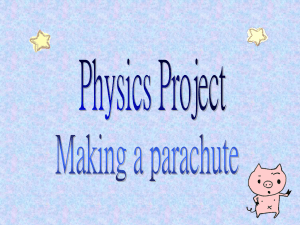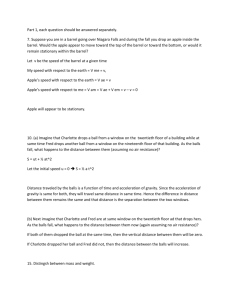Parachutes lab report
advertisement

Harris Nazri Mr. Gammon Science 8 .B 11:03:2010 Lab Report Data (parachutes) Research Question: How do the layers/mass of the parachute affect it’s landing? Independent Variable: Layers of the parachute Dependant Variable: The speed of its landing Controlled Variable: Wind resistance Deployment of parachute at a specific altitude Number of holes inside the parachute to keep it stable while in the air. Way of deployment of the parachute The mass that is attached to the parachute The weight of the mass that is attached to the parachute Amount of strings used to keep it a stable drag across the air while in the air. Aim: Our objectives of our experiment is that we are hoping that we could see some changes in the estimated time of the parachute in touching the ground as we increase the mass/size of the parachute. We hope in conducting this experiment, and see that as we increase the mass of the parachute (increasing sheets of plastics), the longer time it will require for it to reach the ground (see my hypothesis to see my justification). How can we accurately conduct this experiment? We will be constructing a parachute; after we attached one layer sheet of plastic to the parachute, we’ll deploy in the diamond area, with a height from approximately 5m high. After several tries, we would be average the timing and put on another layer sheet of plastic until it reaches a total of 4 sheets of plastic for a parachute. The parachute will be attached to an object with a small mass and weight suitable to make this experiment work, as if that small mass was to be a subject of a person. Method: My colleagues and I are going to be using a plastic paper dimensions of 34x34 centimeters, employ it to construct a parachute and deploy it inside the diamond area from an altitude of approximately 5 meters high. We would be making several tries for one parachute to verify whether our results are accurate, or if there were any interference with the landing of the parachute affecting its dependant variable (approximated time for the parachute to land on the ground). We’ll approximate the time from the several tries we would be conducting, find the average and present the given results in many different kind of formats such as line graphs for the data representation. After several tries with one parachute, we would be reconstructing the design of the parachute, changing its dimensions, changing its mass, by putting on more layers on the parachute, deploy it once more at the same attitude and keep repeating the same process. We would stop when at 4 layers because I think that is an excess amount of mass that is not required to simply for a small mass that is hung on the parachute as if it was the subject of a person. So I guess, making the experiment with 3 additional parachutes, it will have an excess of drag into the parachute, since we don’t use holes inside the parachute, it would ruin the experiment. There are four people inside my group contributing to different tasks inside this experiment so each of us has a job to do while we participate inside a group of 4 that we have chosen for this particular experiment. Felix- constructs and changes the number of sheets of plastics to the parachute. Hamdan- Calculate the time of the released and the landing of the parachute Danyal- Deploys the parachute Me- Brings the parachute from the bottom of the diamond area to the second floor to repeat the experiment, and announces the time when the parachute has been deployed or landed on the ground. Apparatus: Sheet of plastic with dimensions of 34x34 (centimeters) to construct the parachute Stops watch (to see the estimated time for the parachute to reach the ground). String (to attach the mass that will be dragging the parachute down and the layers of the plastics attached with the mass). Small mass attached to the parachute (the mass that is to be the subject of the person hung on the parachute to make the experiment function accurately). Paper Something to write on (to document the results of the experiment) Diagram for the Apparatus: Strings that were included inside the apparatus to accurately construct the parachute (by Sheets of black plastic with the same area (34x34 cm) employed to be layers of the parachute… Paper to document the experiment’s results… Pen/ Pencil to write… Stop watch: to calculate the different times of different parachutes with different mass (different amount of sheets of plastic layers on the parachute). The red circle is the mass that is attached to the parachute in a subject of a person. The mass is no more than 1kg, or else the parachute won’t be strong enough to handle the mass’s weight. Size of the mass is no bigger than the size of a flash drive. Diagram on how the experiment was conducted: Right: A guy releases a parachute from the 2nd floor of the diamond area with a height of approximately 5 meters. As we complete the several few experiments on the first few parachutes, we began to add more layers of sheets of plastics on the parachute increasing its mass and see its results. Left: The parachute with a small mass attached to it in a subject of a person to make the parachute drag with different layers on parachutes. Hypothesis: I hypothesized that as we increase the amount of layers sheets of plastics onto the parachutes (increasing its mass) then it would require more time for the parachute to reach the ground. This is because even though as you include more mass onto an object, the sheets of plastic of paper can glide in the air like a feather. If you dropped a pencil and a bowling ball, the 2 objects would reach the ground at the same time according to one of Newton’s law. But the mass of the sheets of plastic is not heavy, nor dense; basically it drops like a feather so it can glide/drag in the air if it was being released. Meaning that as you increase more mass on the layers sheets of plastics onto the parachute, instead of gaining speed while in mid-air resulting it to drop faster and reach the ground sooner, it’s the complete opposite. Not only didn’t that but our experiment involve any cutting of holes above inside the parachute, permitting the parachute to stay longer in the air, then it takes for only one layer sheet of plastic to support the mass of the total weight of the parachute. Although I think, by the time we reached to the 3rd or 4th layer of the parachute, it won’t be working according to what was expected because I think the mass object (subject of the person) and the area of the plastic sheets of paper are incompatible thus making the experiment results not according to what we predicted. So I think that instead by the time we particularly go onto the 4th layer of the parachute, then it would not work properly, such as the time for the parachute to land on the ground is sooner than expected. Diagram on how the parachute works according to my hypothesis: There are 4 different kinds of forces acting upon the parachute, the strongest one is gravity. Formula for Finding the Drag=mg Mg= (mass)(gravity) = weight Data/Results Since we redo the experiment several times to see whether we can get the timing accurate, verify and avoid any interference such as the parachute gliding in the air, and hitting the sides of the 2nd floor while being deployed in the air affecting the precision of the parachute’s landing time. Basically we just took the couple of tries time we had, and averaged it besides taking the tries time also, which was unnecessary. Here are the averaged time for each different typed of parachutes we conducted: Parachute #1: averaged time: 4 seconds Parachute #2: averaged time: 5.15 Parachute #3: averaged time: 7.1 seconds Parachute #4: averaged time: 4.3 seconds Sizes of the parachute Parachute #1, 1 layer Parachute #2, 2 layers Parachuet #3, 3 layers Parachute #4, 4 layers Representation Line Graph X Axis= Parachute 1 (1 layer of sheet of plastic) Parachute 2 (2 layers of sheet of plastic) Parachute 3 (3 layers of sheet of plastic) Parachute 4 (4 layers of sheet of plastic) Y Axis= Estimated time it took for the parachute for a particular parachute with different mass to reach the ground deployed from a height of approximately 4 meters and a half. Approximate averaged time to reach the ground 4 seconds 5 seconds 7 seconds 4 seconds Graph: The graph symbolizes as more layers sheets of plastic was increased, the longer the time was required for the parachute to reach the ground from an altitude approximately 5 meters high. Although, this experiment was conducted in a place where there was no wind (or air resistance) to interfere the experiment, although, the last experiment with the parachute having 4 layers sheets of plastics shows that time decreased dramatically for it to reach the ground (view conclusion for justification). Conclusion: This data shows that my experiment prove to be accurate; inside my hypothesis I mentioned that the parachute will take a longer time to reach the ground as we add more layers sheets of 34x34 centimeters of plastics onto the parachute because even though the greater mass might trigger into a heavier weight, still, the plastic glides in the air like a feather causing it to stay in the air longer. Although, the mass (subject of a person) that is on the parachute is too light or too small, so by the time it’s time for the 4th layer of sheets of plastic, then the mass/weight of the parachute, the drag it had and the small mass that is attached onto the parachute is incompatible thus making things go differently to what is then expected such as shorter time of period for the parachute to reach the ground (presented clearly on the graph). I conclude that my hypothesis proves to be correct. “as an object’s mass such as sheets of plastic is increased onto a parachute, it will require a longer time for the parachute to reach the ground depending on the air resistance, the object’s mass (subject to be a person), if you were to make all of these things compatible so the data and my hypothesis eventually will concur”. Evaluation: This experiment went really well, and everything went according to the plan that my group and I devised. From the divided jobs we were assigned to, to the method on how we are going to successfully accomplish this experiment (which we did). My hypothesis was proving to be accurate from the data that is represented before. Everything went well; we had sufficient time to finish the experiment, and the write up. We collected accurate data, and we cooperated as a team that made everything went so successful. I think that I would’ve changed anything during the duration of creating this experiment since everything went according to what we’ve planned.








